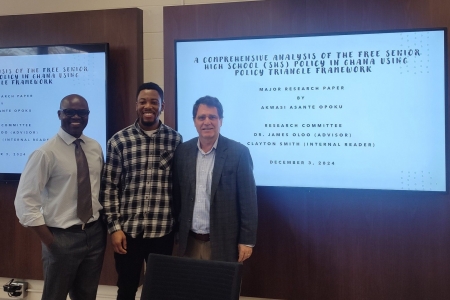 Dr. Smith with Dr. Oloo and Akwasi Asant Opoku following Akwasi's major paper defence.
Dr. Smith with Dr. Oloo and Akwasi Asant Opoku following Akwasi's major paper defence.
Let me offer three words to capture my recent teaching experience: “teaching for learning.”
The writing of Barr and Tagg (1995) has long formed my thinking on how we should teach at higher education institutions. They wrote, “We now see that our mission is not instruction but rather that of producing learning with every student by whatever means works best” (p. 13). But moving from a thirty-year career in university administration to full-time teaching impacted me more than I thought it would. My starting point was closer to what Brookfield (1996) wrote when he described the place that most university teachers start by saying
"The best learners, people for whom learning a skill comes entirely naturally, often make the worst teachers. This is because they are, in a very real sense, perceptually challenged. They cannot imagine what it must be like to struggle to learn something that comes so naturally to them. Because they have always been so successful in their learning it is impossible for them to empathize with learners' anxieties and blockages." (p. 10)
While I thought of myself as learning-centred, it is not clear to me that I have far to go before fully embracing "teaching for learning." What is clear to me now is that embracing "teaching for learning" is something that I will need to continue to work on for the balance of my career.
One of my University of Windsor colleagues, Dr. Tina Pugliese, a faculty member in our School of Dramatic Art, said to me upon hearing that I would be returning to teaching that “teaching is a privilege.” I couldn’t agree more. The completion of the University Teaching Certificate program and Certificate of Open and Online Learning led me to a place where it all began for me: student development. I look forward to working with my colleagues and students in the Faculty of Education to support the development of future educators who are compassionate about teaching and enhancing the lives of those they teach. I am humbled by the whole teaching enterprise and hope that I can make a difference in our faculty, university, and world.
Some of my specific teaching goals for the near future include:
- To enhance my skills in teaching online courses, and my knowledge of digital pedagogy
- To increase the number of graduate students under my supervision who complete their thesis and/or dissertation
- To increase out-of-class applied learning experiences in my classes
- To enhance academic advising of Concurrent Education students
- To enhance my professional learning network through participation in professional associations, including the Society for Teaching and Learning in Higher Education and the Canadian Society for the Study of Higher Education
- To continue taking teaching development courses to enhance my teaching innovation, student engagement, and learning effectiveness
References:
Barr, R. B., & Tagg, J. (1995). From teaching to learning: A new paradigm for undergraduate education. Change: The Magazine of Higher Learning, 27(6), 12-26. doi: 10.1080/00091383.1995.10544672
Brookfield, S. (1996). Through the lens of learning. In L. Richlin (Ed.), To improve the academy, 15 (pp. 3-15). Stillwater, OK: New Forums Press and the Professional Organizational Development Network in Higher Education.
